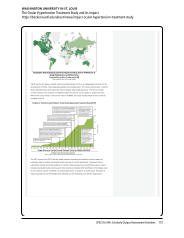60 · Survey Results: Survey Questions and Responses
We expect to see more and more interest in identifying and visualizing scholarly networks. We expect the role of linked
data and semantic web technologies to continue to grow in this area.
We need to see more integration into traditional bibliometrics work. We also need to see more standardization of
the data—that is what is being measured. All of the vendors do it differently. Glad to see that NISO is stepping up in
this arena.
We should know how social networking tools might be used to support promotion and tenure cases for graduate
students, newer faculty, and well-established faculty.
When libraries collaborate with other university units to host assessment tools like VIVO and semprotics, faculty will
have a more formal and trusted means to rely on their use.
ADDITIONAL COMMENTS
25. Please enter any additional information that may assist the survey authors’ understanding of your
library’s scholarly output assessment activities and services. N=24
As indicated earlier in the survey, it should be emphasized that the services available to patrons and the training
activities available to patrons and Libraries staff are generally offered on an ad hoc basis rather than through established
programs related to scholarly output assessment.
Most activities thus far have been related to science, engineering, and medicine groups, with some in business.
One of the successes the library system has had is the grass roots effort to develop a Health & Natural Sciences team.
This is an interdisciplinary group of librarians that has led the initiative for creating activities and services of scholarly
output assessment for the libraries through a series of classes branded as Accelerate Your Research.
Our activities and services in this area are largely left up to individual library liaisons. We do have an expectation that
librarians will provide these services.
Our activities are not coordinated at this time but happen in various departments of the library as faculty needs arise
and training and willingness on the part of library staff continues.
Our activities have been somewhat reactive to date. Support has been provided when requested, but we are working on
developing a more well-defined set of services in this area.
Our response to this survey will rapidly evolve since we have started a major reorganisation of our structure from top
to bottom. New positions will be created in the future while some others will disappear. This will mainly be done by
reallocation of staff.
Scholarly output assessment has not been a distinct focus, but is part of our larger effort to support the scholarly
publishing needs and interests of our user communities.
The university is a decentralized institution, and as a result, the collection of scholarly research outputs is taking place
many times over at the individual, department, college, and campus levels. It is time consuming to collect and report on
this information. Our campus is in the process of implementing the PURE researcher information system for faculty and
researchers, which we hope will help to centralize data collection, automatically capture many outputs, and serve as a
showcase for our research. Improving research analytics is a secondary goal of this project, but we see opportunities for
sharing information across systems, simplifying data collection and activity reporting for colleges.




























































































































































































